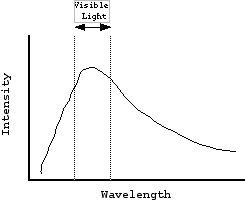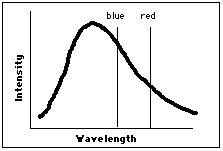
EEEE Light I - Waves and Continuous Radiation, Albedo, Atmospheric Effects
One concept we use to help describe light is the frequency of the radiation.
a) Explain the term “frequency” in plain English. You may wish to use a diagram to help with your answer.
b) Blue light has a shorter wavelength than red light. Would you then expect blue light to have a lower or higher frequency?
--
We use the term “albedo” to represent the fraction of reflected light/received light. It is typically expressed as a number between 0 and 1. For example, an object with an albedo of 0.85 reflects 85% of the light it receives back into space and it appears almost completely white to us.
a) (4 pts) Earth’s Moon has an albedo of 0.06 while Jupiter’s moon, Europa (roughly the same size as Earth’s Moon) has an albedo of 0.64. Neither body has an atmosphere, and both are too small to be subjected to any internal heating. If both moons were placed alone in space at the same distance from the Sun, which would be warmer?
b) (8 pts) Explain your answer to (a).
--
A gas cloud made entirely of element X is giving radiation with a wavelength of 600/300 nanometers. A gas cloud made entirely of Y is twice as far away and is giving off radiation with a wavelength of 300/900 nanometers.
a) (6 pts) State mathematically (and clearly) how the energy in each photon given off by gas cloud X compares to the energy in each photon given off by gas cloud Y.
b) (6 pts) Assuming the two clouds have exactly the same intensity when viewed from the same distance, state mathematically (and clearly) how the intensity of cloud X compares to that of cloud Y when cloud Y is twice as far away.
--
Explain how the greenhouse effect works on the Earth. As part of your answer, discuss both incoming and outgoing infrared radiation. Greenhouse gases block both, so why doesn't that "cancel out", resulting in no net warming?
--
Below is a spectrum of blackbody radiation from an unknown object. What color will this object appear to have? Explain your answer.

--
Below is a spectrum of blackbody radiation from an unknown object. What color will this object appear to have? Explain your answer.
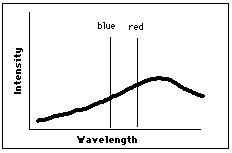
--
Planet X has an orbital velocity four times bigger than planet Y. Using the equation describing an orbit, state how the intensity of sunlight on planet X compares to planet Y. Show your work and state your answer clearly!
--
The atmosphere on Earth can be a real problem for observational Astronomers, due to the effects of atmospheric gases on incoming light.
a) (10 pts) What makes the sky blue on the Earth? Why is this not the case on the Moon?
b) (4 pts) Explain what causes "seeing", or the blurring of stellar images.
--
The graph below represents a solar spectrum as viewed from the Moon, an object with no atmosphere. On the same diagram, roughly sketch what the Sun’s spectrum looks like from the surface of the Earth at sunset. Explain what is causing this change.
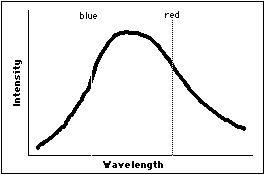
--
On the graph below, sketch a graph of continuous radiation for a Sun-like star. On the same graph, sketch a graph of continuous radiation for a planet like Jupiter. Use this graph to help explain why we can only hope to directly detect planets around other stars by using infrared cameras rather than cameras that use visible light.
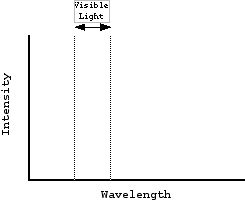
--
A quick way to distinguish between comets and asteroids in the outer solar system is to compare their reflection spectra. Comets tend to appear much redder than asteroids, and because they’re icy, they tend to reflect light more efficiently at all wavelengths (they have a higher albedo). Below is the visible portion of a reflection spectrum for an asteroid. On the graph next to it, sketch how a cometary reflection spectrum would appear. No explanation required.
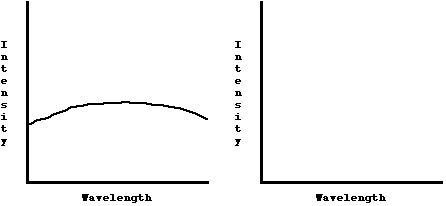
--
Suppose a gaseous planet has a temperature profile in its atmosphere as shown below. Draw the corresponding graph of Temperature vs Wavelength Used in Observation, and explain the shape of your graph.
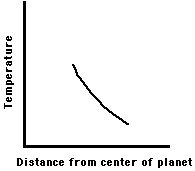
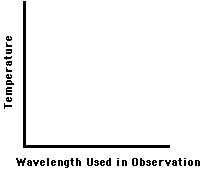
--
At noon on a sunny day, explain why the sky is blue. Also explain why it isn’t another color, like red or black.
--
Two of the giant planets of our solar system, Jupiter and Saturn, are warmed both by sunlight and by their own internal heat. On the far side of each planet you can observe each planet by the light the planet itself gives off (rather than the way we see it from Earth, by mostly reflected sunlight). Seen this way, Jupiter seems to emit its light with a peak wavelength of 0.05 centimeters while Saturn seems to emit its light with a peak wavelength of 0.06 centimeters. Which planet is probably warmer (Jupiter or Saturn)? Explain in a few sentences (just saying, for example, "X is warmer than Y because it emits at 0.05/0.06 centimeters" is not a sufficient explanation... it is just repeating the information given).
--
In tonight’s sky, at about 9pm, if you look toward the South about 40 degrees above the horizon, you’ll see two relatively bright objects. One is the star Spica, the brightest star in the constellation Virgo. Close to Spica on the sky will be the planet Jupiter. An easy way to tell which is which is that (1) Jupiter will be about 10 times brighter and (2) Jupiter will not twinkle like Spica does. Explain why Jupiter doesn’t twinkle while Spica does.
--
If you go outside this evening after sunset and look toward the Northeast, you’ll see the three stars of the “Summer Triangle” just starting to come up over the horizon. Highest in the sky is the star Vega, brightest star in the constellation Lyra, about 25 degrees above the horizon. Much lower in the sky is Deneb, brightest star in the constellation Cygnus, about 5 degrees above the horizon.
Viewed without the interference of Earth’s atmosphere, these two stars would appear to have precisely the same color. However, because of atmospheric effects, tonight one of these stars will appear to be bluer than the other. Which star will appear to be bluer? Explain why in 2-3 sentences (in other words, just saying "X will be bluer because it is Y degrees above the horizon" is not a sufficient answer...it just repeats the information given in the question).
--
The greenhouse effect explains why the interior of a car gets so warm on a sunny day.
a) (4 pts) On the graph below, draw in (and label) the continuous radiation curve for light from the Sun and the continuous radiation curve for your car seats.
b) (8 pts) Use this graph to help explain how the greenhouse effect works to heat up cars on sunny days.
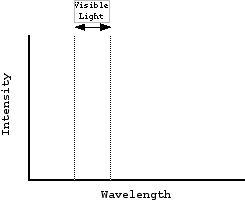
--
If a gaseous planet like Neptune has an external heat source, we expect the planet to appear to be (circle one):
- hotter when viewed with longer wavelengths.
- cooler when viewed with longer wavelengths.
- the same temperature when viewed at all wavelengths.
Explain why observing the atmosphere of Neptune at different wavelengths probes different depths in the atmosphere.
--
Below is the continuous radiation spectrum from an unknown object with a temperature of about 1000 degrees Kelvin (several hundred degrees Fahrenheit). On the graph, draw in a continuous spectrum of an object with a temperature roughly twice as high. Next, explain two major differences between the two graphs. Why does each difference occur?
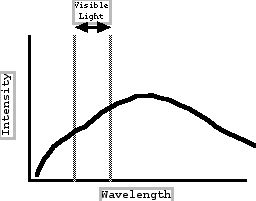
--
On the graph of continuous radiation below, roughly sketch and label the spectra of both incoming and outgoing light to the Earth's surface. Now imagine there is a gas which we'll call X that blocks a substantial fraction of visible light from entering or leaving the Earth's atmosphere. Use your graph to help answer: Will the presence of X in the Earth's atmosphere lead to warming, cooling or no effect on the Earth's temperature? Explain your answer fully in terms of what happens to incoming and outgoing radiation.
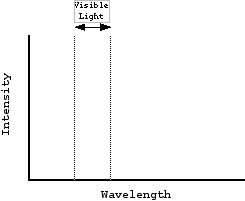
--
The Earth's atmosphere protects us and makes life possible. It has many interesting features about it, but it also makes life difficult for Astronomers at times.
a) (6 pts) Explain how rainbows form in our atmosphere and why the colors are arranged in such a way that red light is on the outer part of the bow while blue light is on the inner part of the bow.
b) (8 pts) Astronomers have designed telescopes to fly in space well above our atmosphere to take advantage of conditions there. Name and briefly explain two reasons why having telescopes in space is preferable to Astronomers.
--
What is a sundog? Explain where it is found in the sky and how it forms.
--
Suppose some gas "X" were introduced into our atmosphere that is exceptionally good at blocking the transmission of visible light. Would such a gas tend to warm up, cool off or have no net effect on the temperature of our planet? Justify your answer. You may use the graph below to help explain your reasoning, but it is not required.
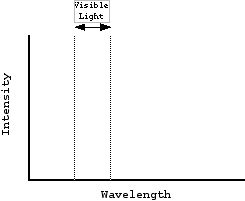
--
The greenhouse effect on Earth is caused in part by the properties of continuous radiation coming from the Sun and the Earth, also known as "blackbody radiation". Explain why this kind of radiation is called "blackbody radiation".
--
The graph below represents a spectrum of incoming sunlight that the Earth receives. Sketch a spectrum of outgoing energy from the Earth. Suppose there were a gas that is really good at blocking the transmission of ultraviolet light (ultraviolet, or UV, is the region to the left of the visible light region) but nothing else. Would such a gas in our atmosphere tend to warm up or cool off the Earth? Sketch a spectrum of outgoing energy from the Earth, and use the graph to help explain your answer.
